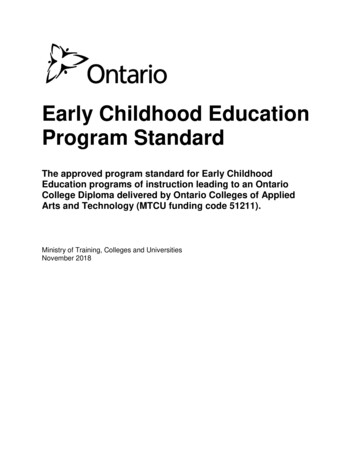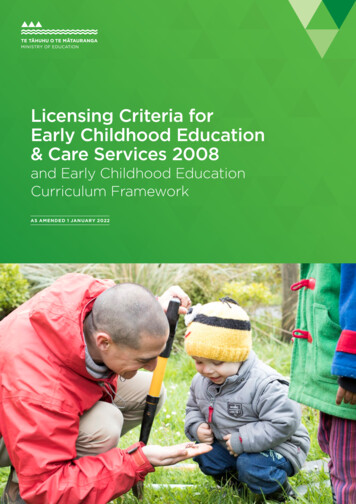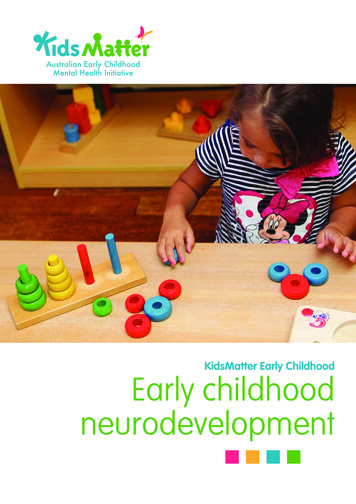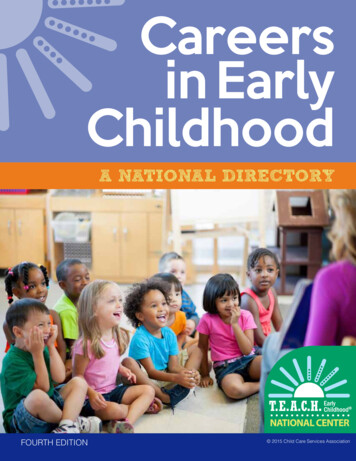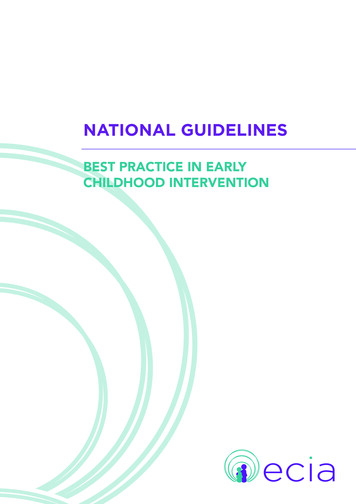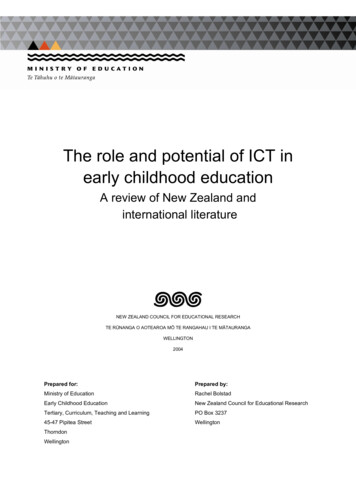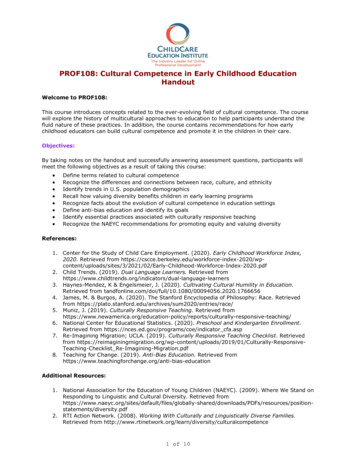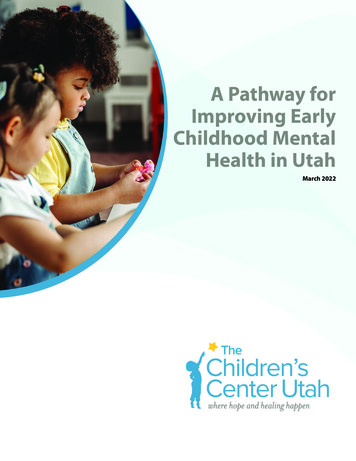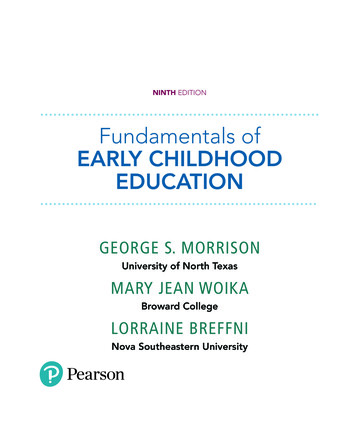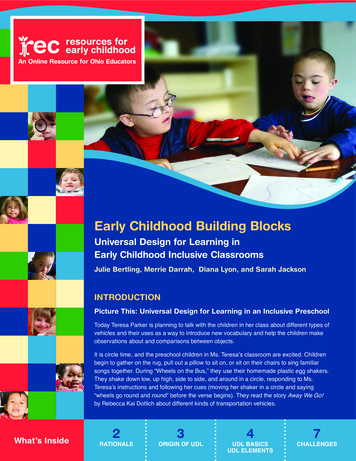
Transcription
Early Childhood Building BlocksUniversal Design for Learning inEarly Childhood Inclusive ClassroomsJulie Bertling, Merrie Darrah, Diana Lyon, and Sarah JacksonIntroductionPicture This: Universal Design for Learning in an Inclusive PreschoolToday Teresa Parker is planning to talk with the children in her class about different types ofvehicles and their uses as a way to introduce new vocabulary and help the children makeobservations about and comparisons between objects.It is circle time, and the preschool children in Ms. Teresa’s classroom are excited. Childrenbegin to gather on the rug, pull out a pillow to sit on, or sit on their chairs to sing familiarsongs together. During “Wheels on the Bus,” they use their homemade plastic egg shakers.They shake down low, up high, side to side, and around in a circle, responding to Ms.Teresa’s instructions and following her cues (moving her shaker in a circle and saying“wheels go round and round” before the verse begins). They read the story Away We Go!by Rebecca Kai Dotlich about different kinds of transportation vehicles.What’s Inside2Rationale3ORigin Of udl4UDL Basicsudl elements7challenges
Two children—Jason and Mylee—are seated on inflatabledisc cushions. They use these cushions to help withstabilization, muscle control, and balance. The extrasupport helps them participate successfully in the groupactivity.also work in the writing area and the art area to writestories and make pictures of their cars and trucks. Theycan use markers, finger paints, glitter glue, or a computerprogram to make their picture.Once the story is over, Ms. Teresa brings out a big brown“magic” bag and asks the children to guess what is inside.She shows a picture on the Smart Board of a firefighterdriving a fire truck. “What does a firefighter drive?” sheasks. Sari says, “Fire truck,” and Ms. Teresa takes a firetruck out of the magic bag and hands it to Sari to hold.Later in the day, the children will have an opportunity todictate, draw, or use a computer program to share storiesof trips in cars, buses, and airplanes. The computerprogram will prompt the children to choose items from apicture library and create a story about them that can beprinted out. The children can click on each picture, and itwill say the name of the object in the picture out loud.After each child is given a vehicle from the magic bag,Ms. Teresa and her assistant have the children take theirvehicles to an area where they can race them down avariety of ramps and chutes that have been set up atdifferent levels to allow the children to reach them if theyare standing or seated. During this time, the children canThe program, which can be used to record children’sspeech and even a song they may want to sing or hum toaccompany their drawings, accommodates the needs ofJamal, who has a speech delay; Asaam, who is learningEnglish as a second language; and Hanna, who is visuallyimpaired.rationaleWhy Universal Design for Learning?Young children have many different physical and learningneeds. A growing number of these children are spendingtheir days in programs similar to the one in the openingclassroom scenario. Jason and Mylee have muscledevelopment problems, Jamal has a speech delay, Asaamis just learning English, and Hanna is visually impaired.These five children are only a few of the children in theclassroom. Each child has strengths and challenges; allchildren do.How can the teachers hope to meet the needs of all thesechildren? Many early childhood teachers have adopted theprinciples of universal design for learning (UDL), but othersare feeling lost and overwhelmed. They need informationand support. This brief Building Blocks article will outlinesome UDL basics in an attempt to address those feelingsand provide access to tools that teachers can use to meetchildren’s needs in the classroom so that they can learnsuccessfully.appropriate setting” (BICC, p. 1). The phrase universaldesign for learning was adopted by the Center for AppliedSpecial Technology, CAST, to differentiate betweenuniversal access, which makes materials available tochildren, and the actual gain in knowledgeand skills involved in learning. The focusmoves from the right of children to bephysically in the room to the right ofall children to be in the room andalso be included and engagedin the general curriculum. Isn’tthat what teachers want—anenvironment where all thechildren learn?The Building Inclusive Child Care website states that “theconcept of Universal Design for Learning (UDL) facilitatesan inclusive early childhood environment by ensuringequitable access and meaningful participation throughflexible and creative approaches within a developmentally2Early Childhood Building Blocks: Universal Design for Learning in Early Childhood Inclusive Classrooms
origin of udlUDL has its origins in the field of architecture. After theAmericans with Disabilities Act and similar legislation wereadopted, buildings began to be retrofitted with ramps,elevators, etc., to accommodate individuals with disabilitiesso that they could gain access to the facility. Laterfindings showed that many others, such as mothers withstrollers and the elderly, also benefitted from the changes.Architects soon realized that it was much more economicalto build accessibility into the designs of new buildingsrather than to retrofit the changes at a later date.In the early 1990s, educators began to realize that thereare similarities between individuals accessing buildingsand children accessing learning through books (e.g.,altering font size, increasing page contrast, and usingaudio, read-aloud, or video). And similar to designingaccessible components in new buildings, they found that itwas more cost effective to apply UDL strategies in creatingenvironments, curriculum, activities, and an assessmentsystem that meets the needs of the greatest number ofchildren during their design than waiting to make changeslater.Inclusion/UDF Observation Questionsand ChecklistThe Building Inclusive Child Care websiteprovides a checklist and a list of questionsregarding a general program, curriculum,physical environment, and relationshipsfor teachers and others to consider asthey prepare an inclusive classroomusing UDL strategies.Along the way, legislators and educators acted to supportthis realization. The Early Childhood Building Blocksbrief “Helping Children with Disabilities Access the EarlyChildhood Curriculum” provides links to and explainsmuch of the legislation. In April 2009 the Division for EarlyChildhood (DEC) of the Council for Exceptional Childrenand the National Association for the Education of YoungChildren (NAEYC) developed a Joint Position Statementon Early Childhood Inclusion. The joint statement suggeststhat the essence of early childhood inclusion is to enhanceevery child’s sense of belonging and support the child’sability to reach his or her full potential. The definingfeatures of those inclusive environments include programsand services that are grounded in three components:access, participation, and support.Defining Features of Inclusive EnvironmentsAccess: All children have access to the generaleducation curriculum and learning environment.Participation: All children can participate in allactivities and routines through scaffolding andintervention.Support: All teachers have the tools they needto help all young children, who have uniquestrengths and needs.3Early Childhood Building Blocks: Universal Design for Learning in Early Childhood Inclusive Classrooms
UDL basicsWhat is UDL? UDL is an approach used in manyclassrooms that allows children to create, explore,and manipulate materials that will foster learningcommensurate with their development and comfort levels,which can be dictated by their strengths and needs.The goal of UDL in education as described by CAST is toprovide “(1) multiple means of representation (the ‘what’ oflearning), (2) multiple means of action and expression (the‘how’ of learning), and (3) multiple means of engagement(the ‘why’ of learning).” To provide these multiple avenuesof learning, the early childhood team needs to consider thelearning differences of all children—including children withdisabilities or different learning styles and children who areEnglish language learners.In a program following UDL guidelines, children shouldbe able to access and engage in all learning opportunitiesprovided in the classroom and in other early childhoodenvironments (e.g., outdoor playgrounds, gyms, artstudios). To make this happen, teachers need toreevaluate the curriculum, physical environment, andrelationships among teachers, children,families, and the community.how do we get there? apply udl elementsHow can we support our children regardless of their ability so that each child can have theopportunity to “participate in a broad range of activities and contexts”? There are somekey components that teachers need to look for when choosing a strategy to helpthem utilize UDL.The strategy should: Foster collaboration with community partners Utilize high-quality, evidence-based practices Make use of a range of service delivery options (large group, smallgroup, and individual; in the classroom, at home) Support differentiation of instructionIn addition, the following three elements allow teachers to frame learningexperiences and classroom environments so that they are accessibleto all children. These elements also rely on the children’s strengths,preferences, and interests to encourage optimum engagement in thelearning experience.4Early Childhood Building Blocks: Universal Design for Learning in Early Childhood Inclusive Classrooms
1“Multiple Means of Representation”In order to support the many ways children learn, teachers needto introduce and share concepts in formats that make sense to thechildren. You might begin a discussion with your team by asking how everyoneis currently relaying information to the children. It gives you a starting point fromwhich you can move out in many directions. You might think in terms of the fivesenses to reach learners in different ways. Be aware that multiple formats aremost effective when they are presented simultaneously; still, not all formats areneeded every time or in every activity. The learning goals may be embeddedacross activities and daily routines, but it is important that somewhere,somehow, sometime, children can experience what they are supposedto be learning in different formats.Representation in Ms. Teresa’s Classroom Touch: Play with vehicles they got from the magic bagTo present the concept of vehicles, Ms. Teresa gavechildren the opportunity to see, hear, touch, move, create,use technology, and verbalize. Move: Race vehicles See and Hear: Hear others singing “The Wheels onthe Bus” song along with seeing the teacher’s visuals,listen to teacher reading Away We Go! while looking atillustrations in book or on Smart Board2 Create: Draw and paint vehicle pictures; write anddictate labels and stories Use Technology: Create personal vehicle stories Verbalize: Sing “The Wheels on the Bus”; tell personalvehicle stories to other children“Multiple Means of Action and Expression”The second element of UDL refers to theopportunities that we give to children that allowthem to show us what they know and what they are ableto do in different ways. We want an accurate picture ofchildren’s understanding of concepts, right? Then we needto allow children to show us what they know in ways thatwork for them but also allow us to get a more accurateassessment of their knowledge and skills.Giving children multiple means of expression is not justabout having many ways for children to share what theyhave learned. It’s also important to give them optionsas they begin to organize and evaluate for themselvesby setting goals and monitoring their progress. Onthe National Center on Universal Design for Learning(NCUDL) website you can read more about theseexecutive functions.Multiple Means of Expression in Ms. Teresa’sClassroom Collected varied types of work: Personal vehiclestories, vehicle drawings, computer printoutsMs. Teresa gave her children many different opportunitiesto share what they had learned. She and the other staffcollected the evidence of those expressions as they: Listened to or recorded children’s voices: Personalvehicle stories shared with other children Observed varied participatory behaviors: Singing andmoving to the music, listening to the story, guessingvehicles during the magic bag game, racing vehicles onramps5Early Childhood Building Blocks: Universal Design for Learning in Early Childhood Inclusive Classrooms
3“Multiple Means of Engagement”This element of UDL focuses on buildingchildren’s motivation and interest in a conceptby providing the children with choices on how they wantto engage in the concept and at what level and by helpingthem engage for a sustained period of time and bepersistent in their learning efforts.Just as children have preferred learning styles, they alsohave preferred ways to engage with activities. And these“rules of engagement” change with the type of conceptsinvolved and as the children’s interest in the activitychanges. Teachers need to be prepared to support alldifferent kinds of learning preferences.It is important to remember, however, that one of the mostpowerful interest motivators is the relevance the concepthas to the child’s personal life. A child who lives in an Ohiocity is likely to be interested in cars, buses, and trucks,because he or she sees them every day and rides in themto go to and from home on a daily basis. A child living ona farm in Ohio might also be interested in cars and trucks,but also tractors and other farm vehicles because they areused by adults nearby and the child sees them often.You can use that interest to motivate children to learnmultiple concepts that are connected to transportationand vehicles—for example, mathematics, language, andscience.It is not only important to be relevant and interesting. It isalso important that all learning activities and areas connectwith the concepts you are trying to teach—for example,people use different kinds of vehicles and transportation—so that the concept persists across time and place. Andactivities need to vary on levels of challenge and supportso that some self-regulation is being encouraged. Thelonger a child is able to engage with a concept, the moreconnections and deeper the learning can occur.Engagement in Ms. Teresa’s ClassroomMs. Teresa gave children the opportunity to engage with an interesting and relevant topic.Interest and relevanceCars and trucks, racing cars, guessing game, and technologyPersistence across times and places Time: Early morning. Place: Class meeting area, where children sing“Wheels on the Bus” and use shakers; listen to story during circle time;play magic bag game with vehicles Time: Later morning. Place: Large open area used for vehicle races andindividual exploration, various learning and activity centers around theroom Time: Afternoon. Place: Various learning and activity centersaround the room, where children compose, illustrate, andshare personal vehicle stories, draw vehiclesLevels of challenge and support needed Low support and challenge: Explore ramps and vehicles Medium support and challenge: Sing, draw, play magicbag game High support and challenge: Compose personal stories6Early Childhood Building Blocks: Universal Design for Learning in Early Childhood Inclusive Classrooms
Challenging but Doable!There are many challenges that must be met inimplementing UDL in an early childhood setting. Teachersneed to provide a range of flexible learning materialsand activities incorporated through visual, auditory,kinesthetic, and tactile opportunities. Teachers and otherearly childhood staff need to offer multiple methods fortheir students to process information. They need to alsoprovide a range of ways for students to demonstrate theirknowledge and learning. Does it sound like a dauntingtask? Perhaps, but take a step back. Look at the wholepicture. Don’t try to do it alone. Engage others on the staffin the process. Get parents involved. Begin to ask yourself:How else can I present this? How else could the childrendo this?To help you provide a successful inclusive classroom,Resources for Early Childhood has developed a sectiondevoted to the Inclusive Classroom on the REC website.In this section, you will find links to additional onlineresources, articles, video examples of inclusion strategiesat work in the classroom, planning resources, and more.And you are invited to participate in the REC Community ofPractice, which brings teachers together online to discussand learn in the company of others interested in earlychildhood education.When you are ready to seek out face-to-face professionaldevelopment experiences that will enrich yourunderstanding of UDL and better prepare you to meet thechallenges associated with it, you may want to contact theEarly Childhood Quality Network (EC Qnet) and the OhioProfessional Development Network. Both offer valuablesessions for early childhood teachers on this topic.tools and resources In the April 22, 2009, archived post on the blog Art and UDL—VSAArts of Massachusetts Blog, you will find a link to Steps for AdaptingMaterials for Use by All Children, a chart that provides examples foradapting toys to make them more accessible and overcome barriers. The Northampton Community College Early Childhood Educationwebsite offers a variety of resources for teachers which includeQuestions to Consider in UDL Observations of Early ChildhoodEnvironments. There is also a UDL introductory video in the RelatedLinks section on the right side of the Building Inclusive Child Carepage. The Center for Applied Special Technology (CAST) provides anexceptional website that has developed resources for educatorsthat answer their questions and promote their adoption of universaldesign for learning. The Center for Community Inclusion and Disability Studies(University of Maine) offers numerous resources. Be sure tosee the Growing Ideas Tipsheets home page and the LearningIdeas Tipsheet: Universal Design in Pre-K and Early ElementaryClassrooms. The Division of Early Childhood (DEC), one of the seventeendivisions of the Council for Exceptional Children, provides a wealthof information and resources for teachers, families, students, andothers in the early childhood community. There are links to positionstatements, journals, and information on recommended practices.One of the especially interesting articles on the website is “TheProject Approach: A Strategy for Inclusive Classrooms” by HeleneArbouet Harte, which discusses how UDL and the Project Approachgo hand in hand in an inclusive classroom. Helping Children with Disabilities Access the Curriculum byVictoria Carr is an Early Childhood Building Blocks article that alsoaddresses inclusion and UDL. The Let’s Play: Projects website from the University of Buffalofeatures a variety of play and toy information, including an articleentitled “Universal Design Means Toys for Everyone.” There are alsoPowerPoint presentations and charts that explain barriers to play andhow to address them and some universal design for play guidelines.Also be sure to see the Universal Design for Play Tool, a rubric thatwill help you make good toy choices for your inclusive classroom. Making Connections with Technology, an early childhood technologywiki, is packed with information, links, video, and PowerPoints and isstill growing. Users can add content to the website. Be sure to minethe site to find all the UDL jewels that are hidden there. For example,listen to the Kindergarten Storybook Voice Thread from LeanneWindsor from the documentation page of the wiki. The National Center for Learning Disabilities (NCLD) includesa Parent’s Guide to UDL—it’s very useful for both parents andteachers. The National Center on Universal Design for Learning offers a myriadof resources including a video introducing UDL. SandboxSeries: UDL in Preschool Wiki is ever changing andgrowing. The participants in the wiki can add and change thingson the wiki to improve the information on the site. Both video andtext-based resources are available to the user through the TrainingResources link.7Early Childhood Building Blocks: Universal Design for Learning in Early Childhood Inclusive Classrooms
ohio early learning program guidelinesSection 2: Environments MatterOutcome 1: The learning environment is organized to support and facilitate young children’s thinking abilities,learning processes, social competencies and general well-being.Goal 2: A comprehensive early childhood curriculum is used to address child development objectives and Ohio’sEarly Learning Content Standards.Performance Indicator 2.4: Educators intentionally plan educational experiences and deliver instructionusing a variety of teaching strategies to meet the diverse learning abilities of all children.Outcome 2: Educators have the knowledge and skills necessary to support children’s learning and development.Goal 1: Early childhood educators demonstrate the competencies necessary to provide high quality instruction.Performance Indicator 1.1: Educators demonstrate their understanding of child development by: Planning experiences that reflect knowledge of the universal stages of development anddevelopmental milestones; Adjusting experiences to meet the uniqueness of all children (i.e., stage of development,temperament, ways of engaging); Carefully crafting a daily schedule that addresses all developmental domains (i.e., time for grossmotor play; opportunities for oral language and social interaction – peer to peer, adult to child andchild to adult; and exploration, investigation and creative expression); Acknowledging the social and emotional feelings of children; and Incorporating knowledge of each child’s social and cultural influences and how they influencedevelopment and learning.Goal 2: Educators demonstrate nurturing and supportive relationships with children to promote self assuranceand competence.Performance Indicator 2.2: Educators evaluate and adjust their actions to respond to differing abilities,temperaments, activity levels and developmental abilities.Goal 3: Educators demonstrate reflective teaching practices.Performance Indicator 3.1: Educators meet regularly to reflect on children’s experiences and to sharecurriculum ideas and teaching strategies.8Early Childhood Building Blocks: Universal Design for Learning in Early Childhood Inclusive Classrooms
about the authorsJulie Bertling is an early childhood consultantfor the State Support Team for Region 6 of Ohio’sEducational Regional Service System. She has beenteaching and supervising work with children withdisabilities for over 25 years in many age rangesand at many ability levels. Julie provides technicalsupport and professional development to programsserving young children within her region.Merrie Darrah is the Early Learning Coordinatorwith State Support Team Region 4 . Merrie has beenin the field of early childhood education for over20 years. She has degrees in clinical psychologyand educational administration. Merrie has broadexperience working with individuals with disabilitiesfrom birth through age 21 including extensive work inthe areas of early childhood assessment, curriculumand instruction, and response to intervention.Diana Lyon is an early childhood consultant withthe State Support Team for Region 5 of Ohio’sEducational Regional Service System. She has amaster’s degree in early childhood education andeducational leadership and has spent the majorityof her career teaching and supervising Head Startprograms in Ohio. She has also taught kindergartenand even spent time teaching science andmathematics with seventh and eighth graders.Sarah Jackson is the early learning/schoolreadiness coordinator for the State Support Teamfor Region 8 of Ohio’s Educational Regional ServiceSystem. She provides services to school districts,Head Starts, County Boards of Mental Retardationand Developmental Disabilities, parents, Help MeGrow/Early Intervention Collaborative Groups, andother agencies and programs that serve childrenages birth through eight, both regular and specialeducation.For more informationContact Nancy Brannon at nbrannon@ohiorc.org or Nicole Luthy at nluthy@ohiorc.org.Visit http://rec.ohiorc.org to see the REC website and other Early Childhood Building Blocks.A Collaboration Project Of9Early Childhood Building Blocks: Universal Design for Learning in Early Childhood Inclusive Classrooms
Early Childhood Building Blocks: Universal Design for Learning in Early Childhood Inclusive Classrooms 2 Two children—Jason and Mylee—are seated on inflatable disc cushions. They use these cushions to help with stabilization, muscle control, and balance. The extra support helps them participate successfully in the group activity.
